Grape care
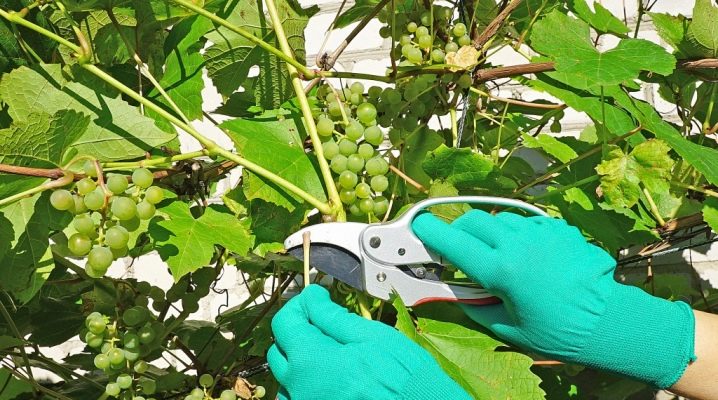
Caring for grapes for many summer residents seems to be something difficult, especially for those living in colder regions. In fact, things are a little different. One has only to understand some of the nuances and it is quite possible to grow a fruiting vine on your site.
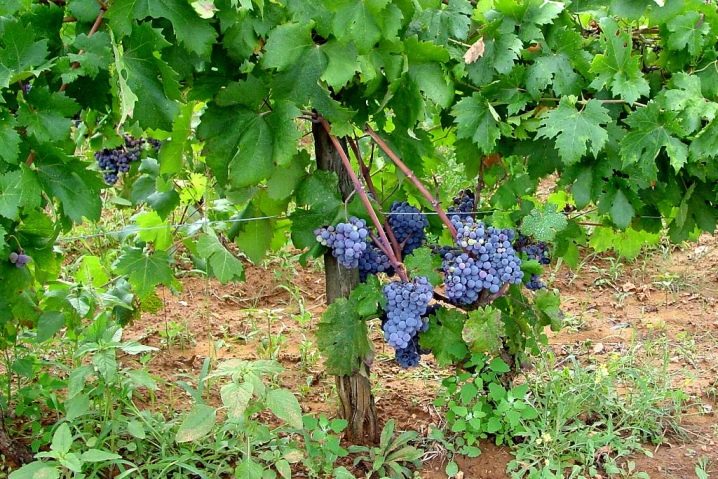
How to prune?
Outdoor grape care includes such an important aspect as shaping. This is a mandatory procedure, since without it the grapes will grow very quickly, and the harvest will be poor. Moreover, the thickets do not look so attractive, even if they are decorative grapes, and the purpose of growing is simply to decorate the site.
Formation is required for the vine, regardless of the region in which grapes are grown - in the south, in the Moscow region or Siberia. Moreover, in each month, this procedure has its own characteristics.
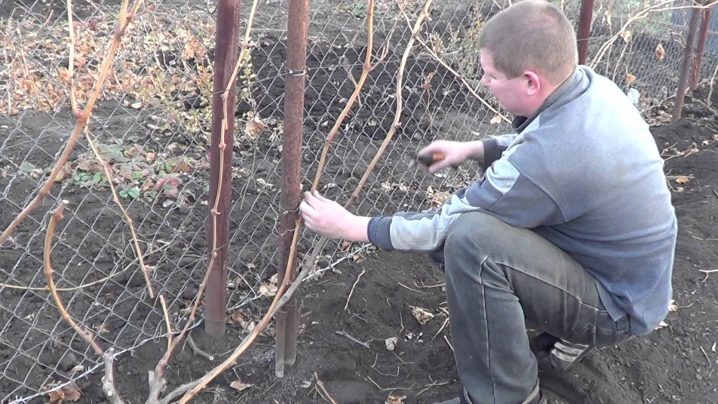
In the spring
Already at the beginning of March, it is worth carefully examining the bushes, provided that they are uncovered grapes and are grown in warm regions. It is worth immediately removing frozen and dry branches. And then you need to decide how many main sleeves the grapes should have. You can leave two, three or four. It all depends on what condition they are in.
If the grapes have been sheltered for the winter, then the shelter should be removed gradually, especially if it is a cold region. For example, open for the day, cover again at night.
Such events begin at the end of March, closer to mid-April they finally open and do pruning.
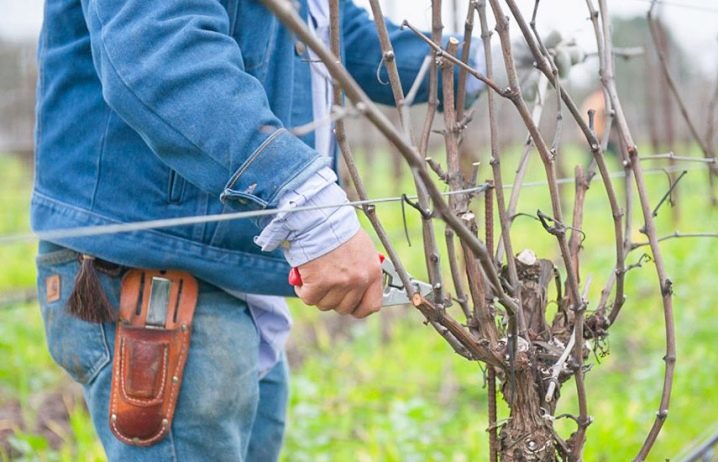
Summer
In June and July, grapes are rapidly gaining green mass, and this process needs to be controlled. If there is no desire to wrap up a gazebo with greenery or wrap around an arch, then it is imperative to examine the vine once a week. Unnecessary shoots, on which inflorescences have not formed, must be removed. This is done so that the plant directs forces to the formation of fruits, and not to increase the green mass. In addition, any dry and damaged leaves should be removed as well. Due to the thickening of the plantings, grapes become vulnerable to diseases and pests.
When the bunches are ripe, it is worth removing the excess leaves in order to provide light access to the fruit.
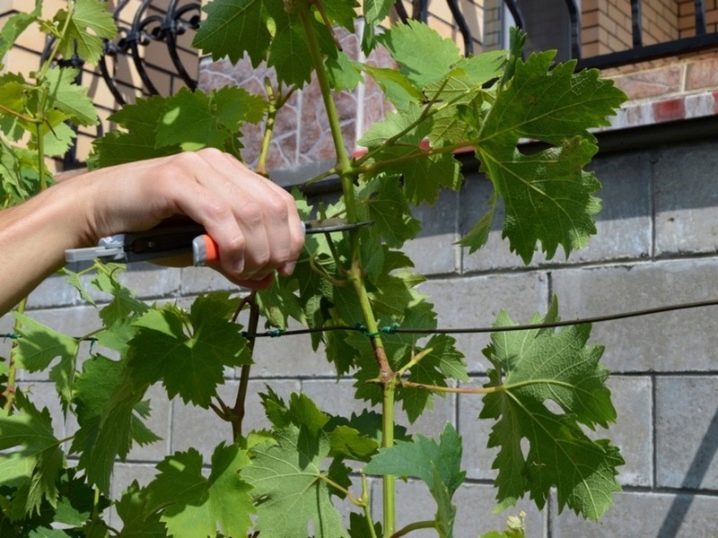
In autumn
With the onset of autumn, when all the fruits have been removed, you can prepare the grapes for winter. It is worth pruning in advance before the onset of frost, and the cut points will need to be treated with garden varnish. The procedure is started when the foliage has completely fallen. It is harvested and burned, because it can contain both bacteria and pests, and it is definitely not necessary for this foliage to winter under the grapes. Then remove all damaged, excess shoots, as well as fertile vines. Unripe shoots are also removed. The remaining ones are left with at least 7 eyes, but no more than 12.
Pruning is done in dry, clear weather.
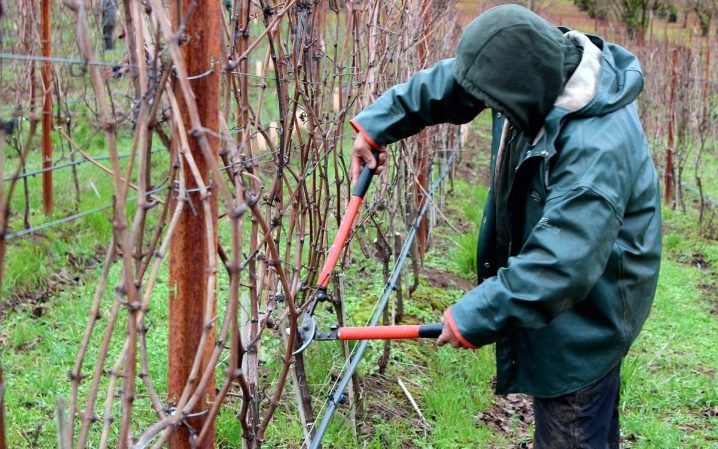
Top dressing
Properly caring for grapes means making sure that it receives all the necessary components that it needs for active growth and ripening of bunches, the development of immunity from pests and diseases, and an increase in the amount of harvest.
It should be noted right away that the grapes need feeding in June, July, August, and September after harvest. But do not overfeed the plants too much, this can cause the opposite effect. It is enough to do this once a month.
During the growing season, the vine needs to be fed. For this very well suited urea, superphosphate and potassium sulfate, combine these substances in an amount of 90/60/50 grams. They are diluted with water in a volume of 40 liters.
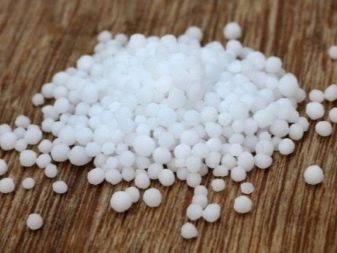
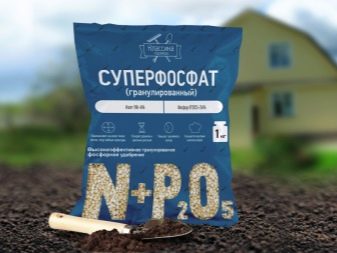
During the flowering period, the bushes can be fertilized with manure (10% solution) or chicken droppings. At the same time, you need to be very careful with these components. It is clear that they are not used fresh. It is best to purchase ready-made granules or solutions adapted to work with plants. Usually, the packages contain detailed instructions that will not allow you to make mistakes and harm the vine.
Top dressing can be applied both under the root and by spraying foliage. Most often, summer residents prefer to apply top dressing at the root, all nutrients are absorbed by the roots and help the plant get them.
Spraying the leaves helps to increase the immunity of plants and more intensely resist diseases and pests.
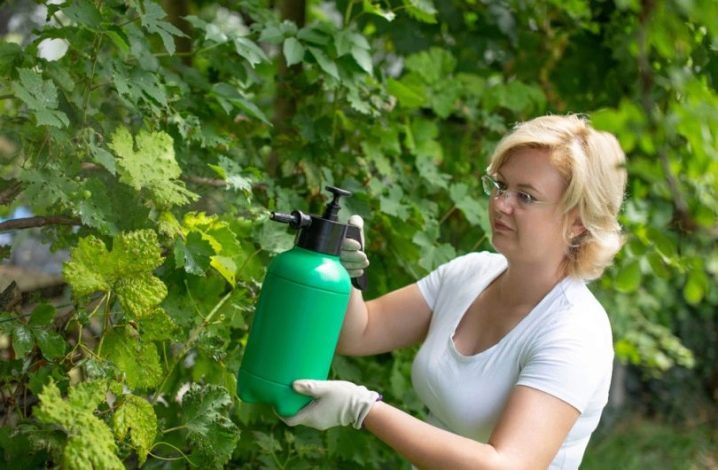
After flowering, you need to focus on fertilizers that contain potassium and phosphorus. This helps to improve the quality and quantity of the fruit. Of course, it should be borne in mind that feeding is not done separately. They are combined with watering. Therefore, care is always comprehensive.
If we talk about folk remedies, then ammonia, ash solution, whey are suitable for grapes both as a spraying and as a fertilizer under the root. In the last months of the season, nitrogen should not be used as fertilizer. To feed the bushes before winter, it is better to focus on potassium and phosphorus. Moreover, the last feeding should be done before the frost for at least two weeks.
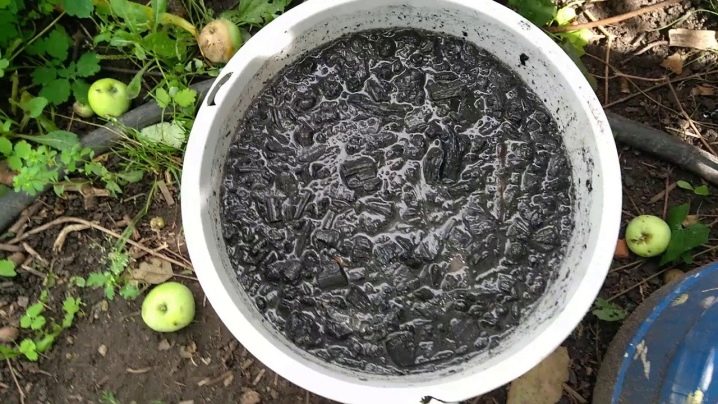
Watering
Growing grapes in the country in the open field or in a greenhouse requires regular watering. This is especially true for freshly planted grapes. To grow healthy fruit-bearing grapes, it is necessary not only to feed them regularly, but also to water them in a timely manner. It is clear that when it rains, the plants do not need watering. On ordinary sunny days, the vine should be watered once every two weeks. Pour 30 liters of water under each bush. At the same time, this must be done carefully, watering the near-trunk circle. Be especially careful when inflorescences appear on the vine. They are quite fragile, and you should not disturb them once again, all procedures should be carried out very carefully. The same applies to the ripening period of the bunches.
When the seedlings were just sent to the open ground, they need to be watered every week, 10-15 liters under the bush.

Mature grapes over three years old can easily withstand a drought, and even for a month. But overdoing it with watering is dangerous. From an excess of moisture, various diseases can begin, and the roots can simply begin to rot.
Before preparing for winter, the grapes require water-charging watering. Usually all these events take place in early October, but in the southern regions this period may shift to early-mid November. It all depends on the weather conditions. In the northern regions, preparations for winter may begin as early as late September. Watering is carried out in the amount of 100-120 liters of water for each bush. The next one will be produced in the spring, after the snow melts. In the southern regions, where there is practically no snow in winter, the first watering can be carried out if there was no rain before, in late March - early April.
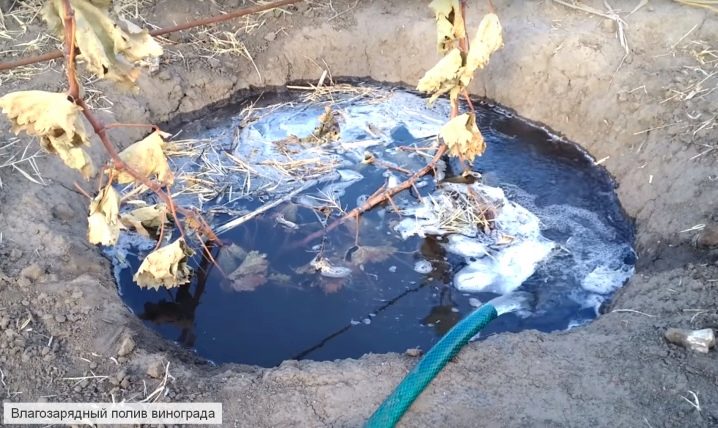
Tying
It is worth immediately knowing such a nuance that the grapes must be tied up. This information is especially relevant for novice winegrowers. As long as the grapes are small, they can still grow if planted in the fall. Most often, growers use this particular time of year for planting. When the vine is 1 year old, a garter is required. For this, trellises are installed. They can be metal or wood, less often plastic, but the plastic must be very durable.
Tapestries are a structure in the form of sticks, located vertically at a distance of one meter from each other. A string or fishing line is pulled between them, it is better if it is three tiers. The lower one is at a distance of 10 cm from the ground, then the middle and upper ones. The vine will then be guided along these strings.When all the proper care of the one-year-old grapes has been carried out, pruning has been done, it is worth controlling the growth of the grapes and placing the vine so that the bush grows correctly, the bunches receive the optimal amount of light and at the same time do not interfere with each other.
If you plan to place the vine on a gazebo or a special arch, the situation is even simpler. The grapes need to be planted near the gazebo or on both sides of the arch, then you just need to direct the vine along the supports, and as a result, you get a cozy green corner.
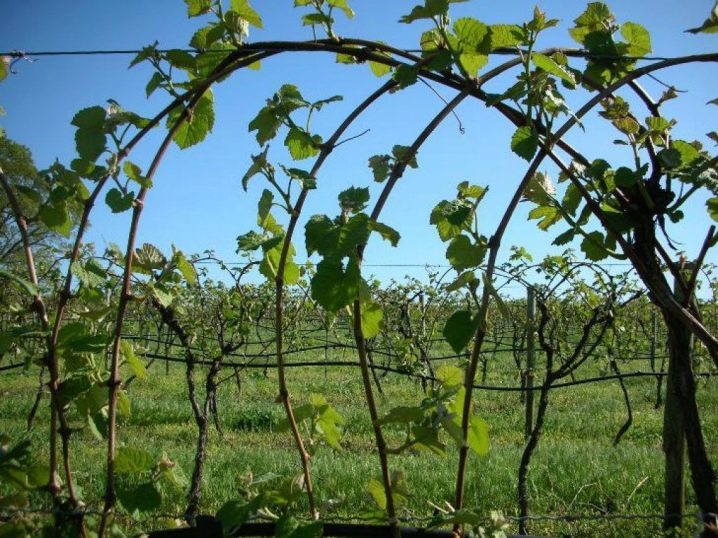
Shelter
It is necessary to cover the grapes for the winter at home only after all the work has been completed: all unnecessary shoots are cut off, the leaves are removed, watering is done, and the last dressing is done. Ash can be used as the latter. Besides, if the grapes were sick during the season, it should be watered at last with a solution of copper sulfate. The soil can be covered with compost, hay or sawdust. In the southern regions, grapes are not harvested, they will feel great anyway. But where frosts occur and heavy snow falls, grapes simply will not survive without shelter. Therefore, the vine is carefully removed from the trellises, laid on the ground, previously covered with mulch. Then a covering material is placed on top, then you can cover it with a layer of branches and hay.
When snow falls, it is thrown over the vines placed under the covering material. In this state, the grapes usually winters well.
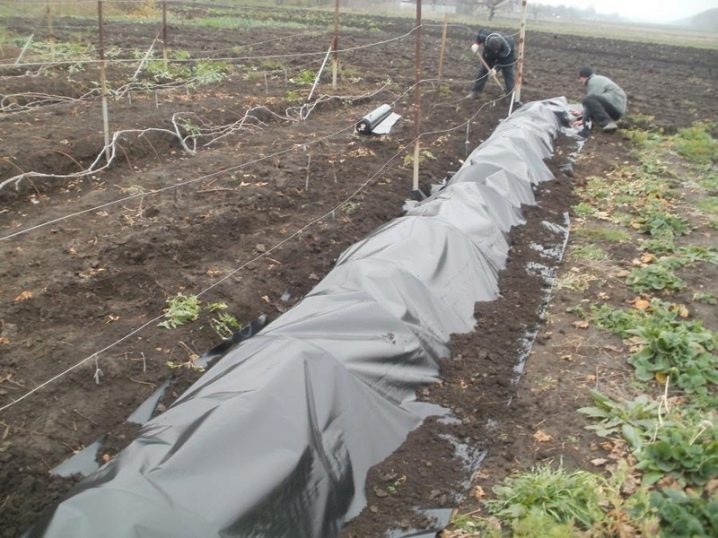
Diseases and pests
The garden plot is one way or another exposed to the invasion of pests and diseases, and grapes are no exception. That's why at the summer cottage there should always be an arsenal of tools that can be used. And it is best to make preventive spraying in order to avoid infection of the vine or active reproduction of insects. It also happens that when the disease is running, it is already difficult to cope with it.
Most often grapes are affected by diseases such as powdery mildew and powdery mildew. To prevent the disease, you should spray the grapes with "Fitosporin". Be sure to treat the vine with Bordeaux liquid in the spring and water the soil with it. This will prevent the growth of harmful fungi. From folk remedies, you can choose soda by diluting it with water in a proportion of 100 grams per 10 liters.
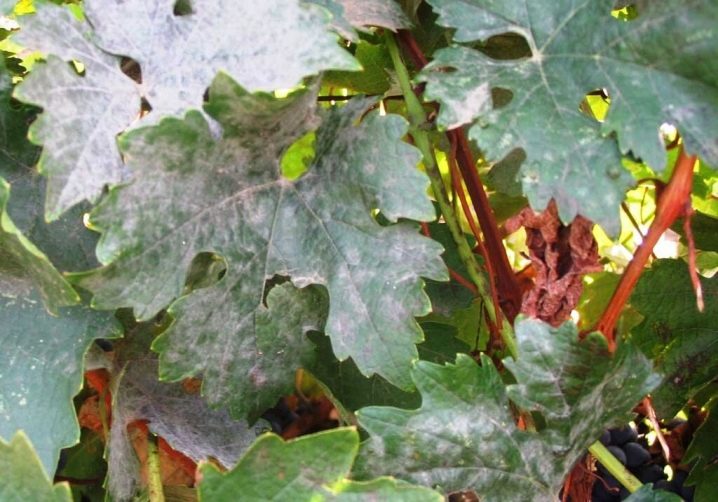
As for insects, spider mites and aphids are especially unpleasant in this regard. Aphids settle in whole colonies on the inner side of the leaf, drinking all the juices from the plant. The tick also begins its invasion from the inner plate of the leaf; it occupies the territory very quickly. As a result, the leaves become covered with white spots, then they turn yellow and dry out. Following this, the bunches also dry out. From insects, bushes can be treated with drugs such as Fitoverm, Fufanon-Nova, Apollo, Aliot.














The comment was sent successfully.